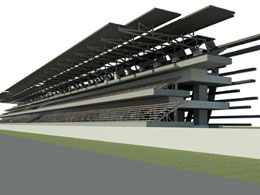STUDENTS PROJECTS
PROJECTS2012

01 September, 2012
Serres Racing Cirquit
Functional upgrade of the cirquit, in order to host a Formula 1 grand prix.
Students: Vassiliades Constantinos, Vollas Dimitrios
Supervisor: Kastro Edouardos
AUTH faculty of architecture
Date : Ιούλιος 2012

Brief Description: A Formula 1 race, is a very important sport-economical-cultural event for every host country. This thesis aims to upgrade the functional operation of the track, in order to accommodate such an event.
Accompanying text:
The Serres Racing Circuit is located south-west of the city of Serres, in Omonia Athletic Park. The track is the largest in the Balkans, with a length of 3186 meters and meets the requirements of the technical safety levels of Formula 3. It serves athletes and teams from many countries of the Balkans and the eastern Mediterranean like: Bulgaria, Skopje, Turkey, Bosnia-Herzegovina, Romania, Israel etc. These were the main reasons for choosing the particular track for the preparation of this project.
The proposal moved in two main aims. Initially the focus was on the track and in its wider area, in order to meet the Formula 1 regulations. The length of the track rose to 4150 meters, the grandstand and the building of the pits were upgraded, and a building for the VIP was created. At the same time the traffic networks and the viewing areas within the track, were restated. So there were some differences in the existing network by separating it into the network, which is directly correlated with race (athletes, staff) and a network for the public (spectators, visitors), ensuring that the safety cars will have access to the entire track without interrupting the race. The grandstands and the relief map of the area were formed in such way to allow viewers to have a good visual contact with the track.
The second important aim, was the transformation of the track and the general park, in a sport / culture area that is open throughout the year. To accomplish that, a hotel, a museum and a sports center were created and they were put in such way to be able to serve out the race, but also serve the function of the park during the "no race" periods.
The basic architecture of the buildings was based on the fact that the start / finish line is the most important aspect of a motorsport race. At this point the power and speed of the cars reaches its peak, leaving their traces on the start / finish line as bright imaginary lines which are being transformed into buildings, shelters, plantations, moving in the area, connections (between buildings)etc. Moreover, the facades of these buildings were resolved with a morphological grid perpendicular to the linearity of the whole.
Finally, the automobile museum, which is the "functional anomaly" of the whole, as well as the morphological anomaly, as its form does not follow the linearity of the other buildings, but it is inspired by the most basic element of the engine, the pistons instead. The formation (design)of the facade of the museum, has been made in a way to resemble the imaginary motion lines.









Related articles:
- WORLD CUP FIFA 2010 ( 17 June, 2010 )
- F1 Circuit ( 28 November, 2010 )
- Indoor sports hall in Alexandroupoli ( 12 January, 2011 )
- “Sports center at the University Campus of Patras” ( 08 March, 2011 )
- Portable Extreme Park ( 03 April, 2012 )
- Ecotourism centre - marine park facilities in island "Kelyfos" ( 17 January, 2014 )
- ALKYON. Sailing club of Rafina, Athens ( 20 August, 2014 )










